Bloomington city council candidate forum: Indiana University connections
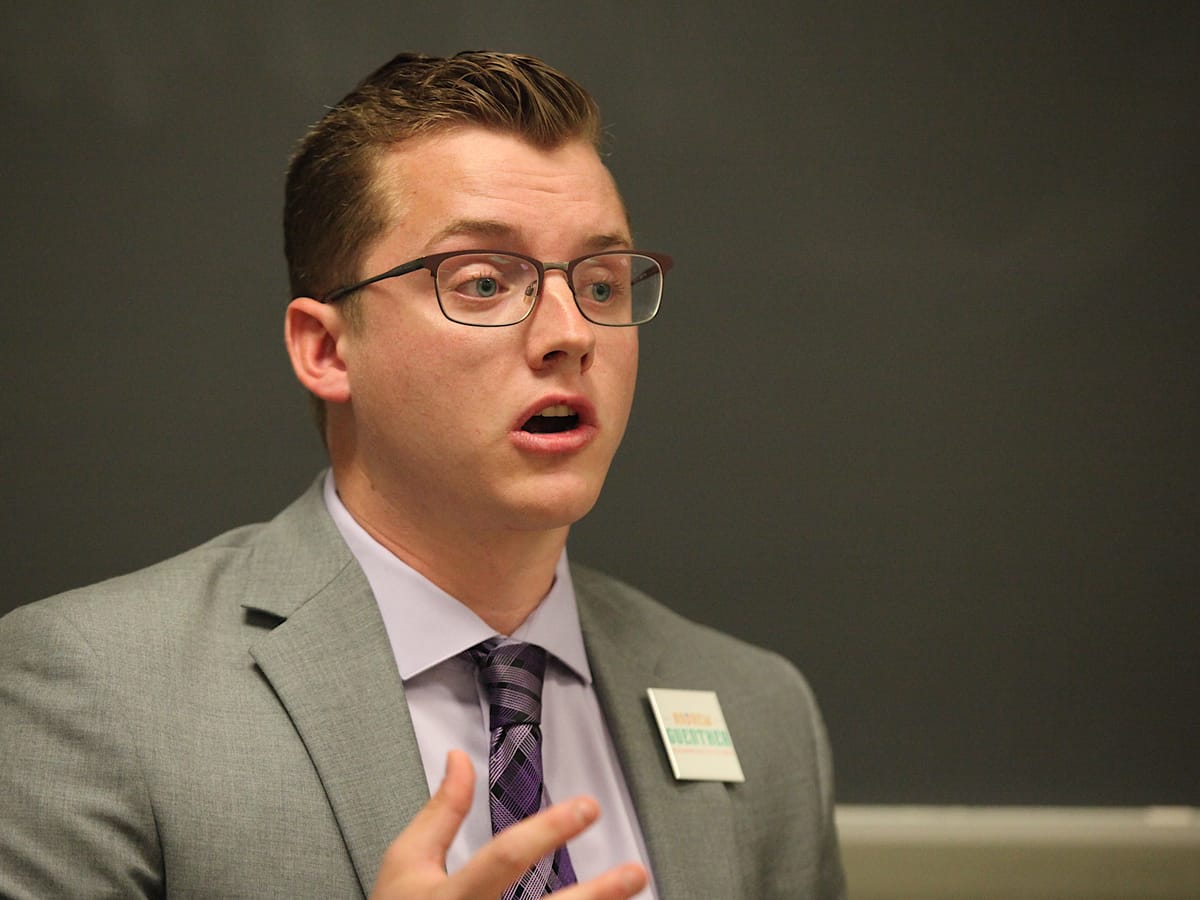

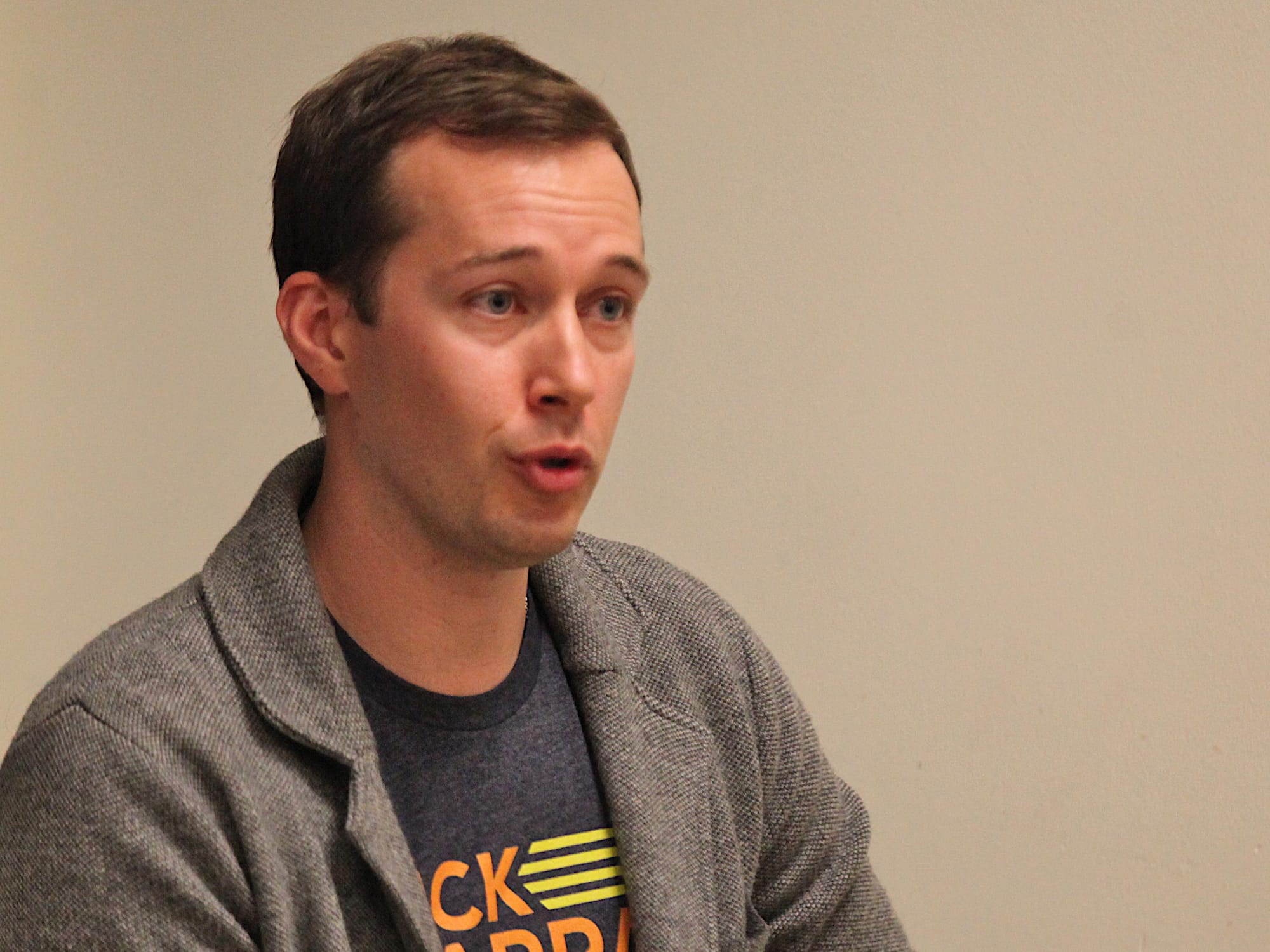
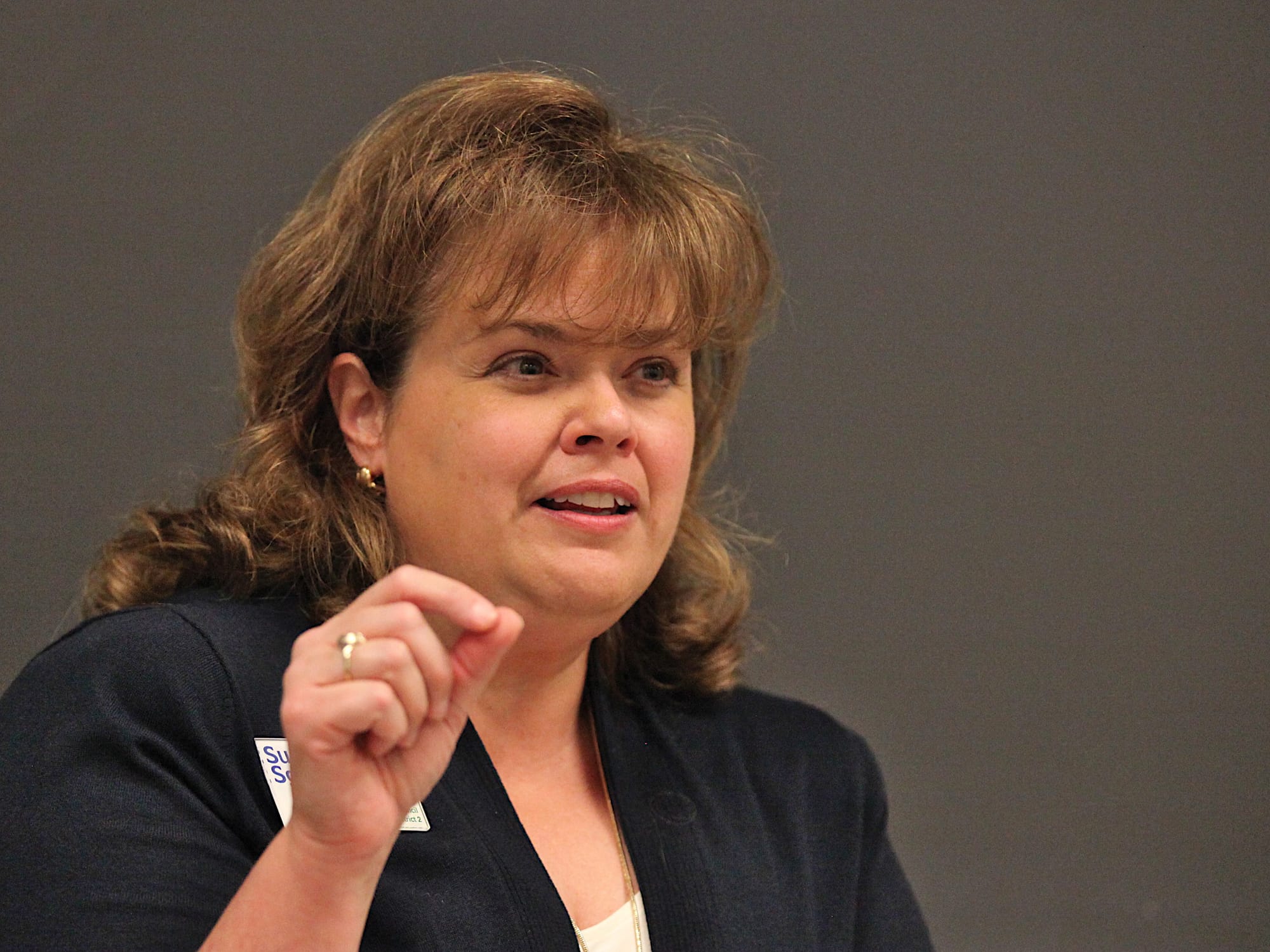
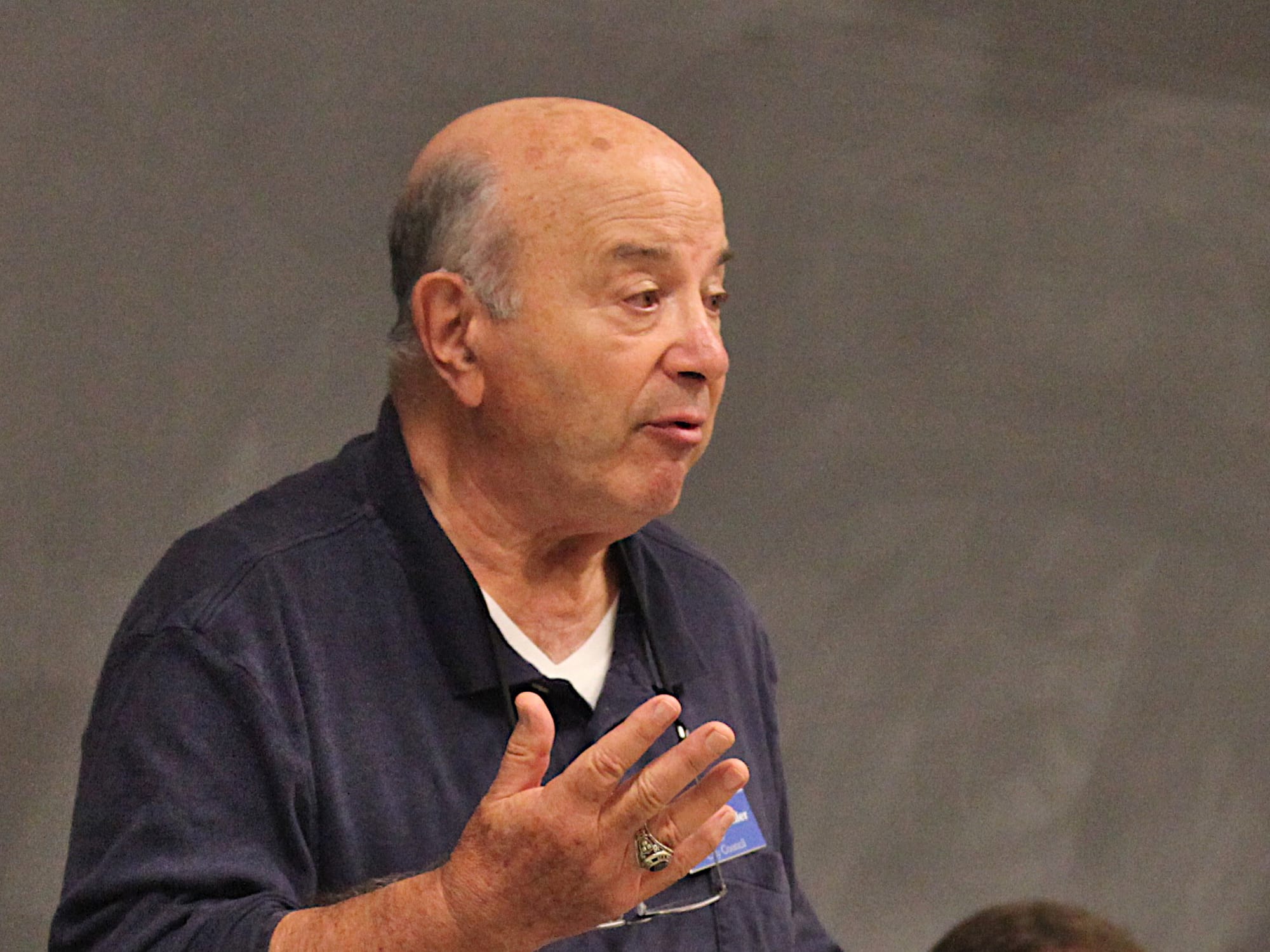
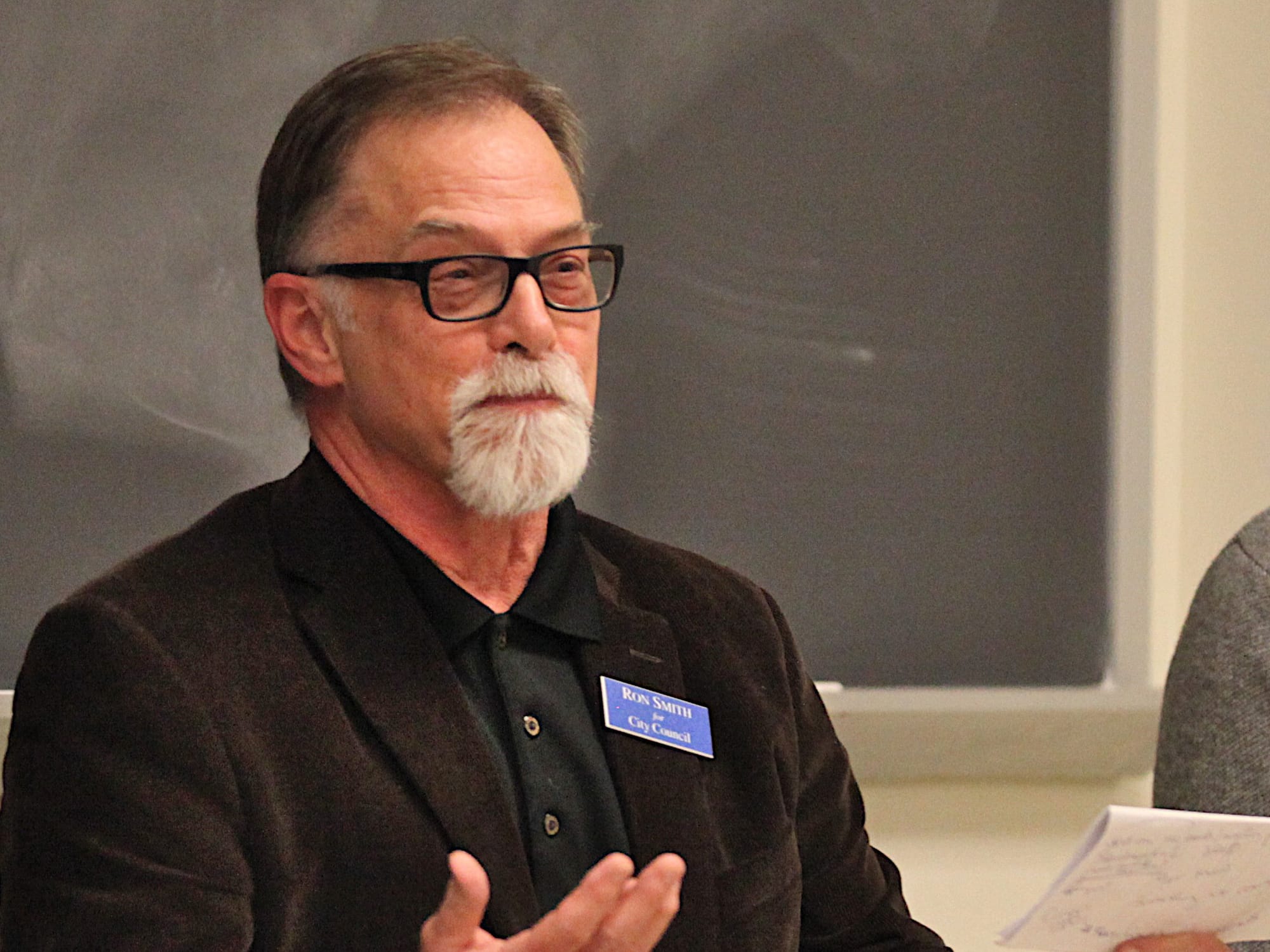
Last Monday (Oct. 29) all five candidates in Bloomington’s city council elections—held only in District 2 and District 3 this year—appeared on Indiana University’s campus. They participated in a forum hosted by The Civil Society at Indiana University. Moderators were students Meredith Karbowsky and Tyler Combs.
The event was held in Woodburn Hall, Room 004, in the lower level of the building, which features slate chalkboards and auditorium-style seats, bolted to the floor, with built-in swing-up tablet arms.
The venue itself got a mention in their introductory remarks from two of the candidates. District 3 independent candidate Marty Spechler told the group he is an emeritus professor of economics at the university—and he’d taught classes in the room. District 2 Republican candidate Andrew Guenther, a recent graduate of the school, said he was glad to be back in the room, where he’d just recently taken political science classes.
Guenther’s opponent in District 2, Democrat Sue Sgambelluri, also holds a degree from IU and works as development director for the college of arts and sciences. In District 3, the other two candidates, Democrat Ron Smith and independent Nick Kappas, also have connections to IU through degrees they earned there.
Most questions asked by moderators were either directly or indirectly connected to the university.
Candidates were asked how they would strike the balance between representing student interests and representing the interest of Bloomington locals. They were also asked how they would ensure student access to quality housing. Based on some recent shootings that did not prompt IU Notify alerts, candidates got a question about how they’d maintain and improve public safety in Bloomington.
Climate change was topic that candidates were asked about, which was not prompted by a university-specific connection.
Earlier reporting on the forum by The Beacon covered the topic of white supremacism as it relates to Bloomington’s farmers market.

Students versus Bloomington locals
Ron Smith called it a hard question. A good example of this, Smith said, is the question of shared-use electric scooters. Lots of students ride scooters, he said. He said he wasn’t sure he has a great answer, but said he felt the city does not always coordinate with the “really big monolith” of the university. Smith said he was not sure that the university’s president, Michael McRobbie, listens very much to Bloomington’s mayor, John Hamilton. He didn’t mean that observation in a disparaging way, Smith said, it’s just that the president of the university is probably not thinking too much about what the city is doing or what the city thinks. He suggested that transportation is an area where the city and IU could coordinate—each has a bus system.
Marty Spechler said scooters should be allowed on campus—students need them to get from, say 15th Street, to a campus building like Woodburn. He would not allow scooters in the downtown areas, he said. Scooters are dangerous to pedestrians, he said. As far as influencing the university administration, Spechler said was elected seven times to the faculty council and knows the university presidents, past and present. As a former city councilmember, he has the ability and willingness to talk to top-level university administrators on their level.
Nick Kappas agreed that there’s no incentive for the president of the university to talk to the mayor. But he said the question is how student issues can be balanced with the city’s issues, not how the higher-up’s issues can be balanced with the city’s. About scooters, Kappas said at first he didn’t like them, but now he understands that they allow students better mobility—scooters cover the last half mile or quarter mile of their trip. Some additional enforcement would help, Kappas thinks, but is not in favor of a blanket prohibition of them in the downtown. The affordability of housing is something the city council can help with, Kappas said, and alluded to the pending update of the unified development ordinance, which could allow duplexes and triplexes under certain conditions. Kappas said city officials don’t really know everything that students are concerned about. Something the city council can help with is livability and quality of life—so it’s important for city councilmembers to know what quality-of-life issues students have. Kappas said he would move on those issues.
Andrew Guenther said as a 25-year-old he has an advantage dealing with the issue. He thought he was the only candidate who rents, instead of owning the place where he lives. Very few city councilmembers or city staff remember what it’s like to be a student, he said. He said he walks places and uses public transit, so he knows the gaps in public transit. As far as scooters go, he has no problem with scooters, but does not think they belong on sidewalks, because they are motorized vehicles. He’s supportive of installing protected bicycle lanes and allowing electric scooters and electric bicycles to use bike lanes. Guenther said he doesn’t think sidewalks are all that great for riding scooters because many of the sidewalks are not in a good state of repair. The city council is not investing enough in sidewalks, Guenther said.
Sue Sgambelluri said she thinks there are some things that are more important than scooters. First, she identified an issue with the “mindset” reflected in the question. Representing the community is representing students and representing students is representing the community, she said. The second thing, Sgambelluri said, is close consultation with students. After filing to run for city council, she’d met with the Indiana University Student Association liaisons to the city council and she’d asked them what they think is most misunderstood about students as citizens. Third, Sgambelluri said that personal and professional networks are important in this town. While people might think of McRobbie as the person in charge of IU, Sgambelluri thinks it’s sometimes more valuable to sit down with Tom Morrison, who is vice president of capital planning and facilities.
Ensuring student access to quality housing
Ron Smith mentioned the pending revision to the unified development ordinance that’s being considered by the city council. Whether duplexes and triplexes should be allowed in core neighborhoods is an issue that will take a while to solve, he said. Smith said that as a resident of Bloomington, it bothers him that the university is “abdicating” its role of providing housing for students. As the university has added students, he does not understand why it’s not incumbent on the school to provide housing. That’s why housing costs for people who are not students continues to rise, Smith said.
Marty Spechler said the city and the university are separate entities and the amount of influence the city has on the university is “rather slight.” The housing question should be considered in terms of supply and demand he said. Demographic projections indicate the number of students probably won’t increase beyond what we have now, Spechler said. To increase supply, Spechler said, it needs to be easier for developers to build housing here. Bloomington is considered a very difficult place to build, Spechler said. If you build new market rate housing, that increases supply and makes older apartment available, which will have lower rents. We can’t build new affordable housing, Spechler said, and that means we need to look instead to used or renovated housing—that’s much cheaper.
Nick Kappas said he’d worked on revised unified development ordinance for the last couple of years as a member of the plan commission. The key question, he said, is: Where do we put the density? Everyone feels like it’s just going to go into core neighborhoods, but it’s meant to be spread out across all of Bloomington, Kappas said. Convenants are stopping some people from accessory dwelling units or duplexes. Neighborhoods need to take a step back and re-look at themselves and ask how they can help the broader picture, he said. Kappas doesn’t agree with building monolithic structures of student-oriented housing over and over again, because they “ruin the fabric” of Bloomington. The apartment he lived in 10 years ago has increased by about $100 a month, but it’s located about 2.5 miles away from campus. That has implications for the need for better public transit, he said. To house everyone, it takes the entire community, Kappas said. Part of that is a unified development ordinance that would allow duplexes and triplexes and ADUs in new developments.
Andrew Guenther said housing affordability and availability is important to him as someone who rents. He agreed that it’s generally not possible to build new affordable housing, because developers build it as market rate. Older apartments become more affordable, he said. Jackson Heights, where he now lives, used to be a popular “party-central” IU neighborhood. Over time it’s become home to lower -income families and work force families. We need to relieve pressure on buildings that are older, by decreasing fees and decreasing taxes, he said. Guenther said as chair of the city’s environmental commission, he has pushed for increased height in student-dense areas. Students don’t mind increased height, he thinks, but they do mind large buildings that take up entire city blocks. As a member of the board of housing quality appeals, so he heard complaints by students against landlords. He said we need more Housing and Neighborhood Development (HAND) inspectors to make sure properties are kept up to standards.
Sue Sgambelluri said housing is a multidimensional issue. She thinks there are short-term and long-term considerations. Bloomington is going to grow, but we need to make sure it grows intentionally, she said. One thing we need to do is make sure projects have “baked in” elements of affordability. As an example, the city’s redevelopment commission (RDC), on which she serves, is responsible for the certified tech park. As a part of that development plan, the RDC included B-Line Heights, which has 36 affordable units in perpetuity. There are additional opportunities to do that elsewhere in the city, she said. Sgambelluri also pointed to transportation as a key element of affordability—it’s not just the price tag on the bedroom, it’s a question of whether you need a car because the bus service is not a feasibly option. A recent development approved for North Walnut included funding for a public bus route, she said, which is the kind of negotiation that an effective councilmember could do on behalf of students.
Maintaining, improving public safety
Ron Smith said the city council had approved the 2020 budget presented by the city administration, which includes two additional police officers. He agrees with the idea that we need police officers on the street. As a city councilmember he would would ask Bloomington’s police chief Mike Diekhoff and the Monroe County’s sheriff’s department to come together and talk to the city council about solving gun issues and shootings. Police officers are on the street and know what’s going on, he said. City councilmembers are just people who might implement some changes that law enforcement officials might ask for, Smith said.
Marty Spechler said the most important thing the city council can do to improve public safety is increase the number of sworn police officers. Bloomington has the smallest police force in Indiana of any city Bloomington’s size, he said. The mayor has refused to budget for more police officers or settle the union contract, which Spechler said is long overdue. Police and fire protection are two things that no local government can do without, he said. Bloomington is “skimping” on police protection, as well as fire protection, Spechler said, because the mayor has refused to build a new fire station on southwest side.
Nick Kappas said first thing city councilmembers should do is seek to understand—why certain crime hot spots aren’t being prioritized, for example. He agrees that there are not enough police officers for the area that needs to be patrolled. The budget constraints have to be understood. Kappas said it was startling that the police chief had asked for only two additional officers, when it should have been closer to 10 or 12. There’s only so much a councilmember can do, Kappas said, but he wants to be a leader challenging boundary lines to start collaborations. Getting coordination between other public safety agencies like IUPD and the fire department is important, Kappas said.
Andrew Guenther said he’s pushed the mayor to ratify a new union contract, because he believes what the police officers are saying is correct: There aren’t enough police officers, which means they’re putting in too much overtime and they’re overworked. He rarely see police where he lives, on West 17th Street, and there have been three shootings in his neighborhood since he moved in around a year ago. The contract needs to be ratified and more police officers need to be put on the beat, he said. He said he wants to know exactly what the policy on IU Notify is. Is it defined geographically, or by whether IU students are involved, whether there is a threat to public safety?
Sue Sgambelluri said public safety is function of multiple issues. It’s not just how many police officers or just the number of street lights. The police force has to be supported, she said—she has family in law enforcement, so she knows first-hand the danger they deal with every day. She takes seriously the obligation to staff and train police officers well. Sgambelluri thinks the city can promote more coordination between city and university—there are times when the two entities don’t coordinate as well as they should. Everything is about resources, and finding sources of money that can be mobilized is something she could do on this issue, she said.
Climate change
Ron Smith said he thinks about climate change because he has a grandson who is 15 months old. Older buildings need to be retrofitted and new buildings should be made as green as possible, he said.
Marty Spechler said climate change is the challenge of this and all future generations. The most effective measures could be be done on the national and international level. But in Bloomington, he said there are three things: plant more trees; increase availability of solar panels in public buildings; and make Bloomington a model of doing the right thing throughout the state of Indiana and the country.
Nick Kappas pointed to his experience as former chair of the city’s environmental commission, and as coauthor of the city’s environmental action plan. That plan called for it called for increased tree canopy. As he canvases District 3 he’s seen stumps that have not yet been replaced. The city has a 50-50 program for helping to replace sidewalks, and he thinks that could be extended to tree replacement. Kappas called for more collaboration with IU on climate change.
Andrew Guenther said he was glad to hear that the city’s redevelopment commission had baked environmental standards into the 4th Street replacement parking garage. As a member of the environmental commission (EC), he participated in the commission’s review of all the planned unit developments that go in front of the plan commission and the city council. The EC gives recommendations to add features like solar panels, or bioswales—if the project is in an area prone to flooding. The city council should listen to the EC more, Guenther said. With respect to new development, in Bloomington, “height” is a four-letter word. He thinks there are some areas of the city that could thinks can handle more height. More height means a building allows for more green space. What really takes away from the aesthetic is no green space, Guenther said.
Sue Sgambelluri said one thing the city can do is require sustainability features in every new structure in town. As an example, she gave the design for the 4th Street parking garage. The city’s redevelopment commission, on which she serves, wrote into the financial approval for the new garage, certain sustainability features. Sgambelluri also said alternative sources of funding are needed to retrofit existing buildings. Investments need to be made in public transportation, because transportation is a major contributor to greenhouse gas emissions. There is one bus route that runs up by her house, Sgambelluri said, but it runs just once an hour—that’s not enough.




Comments ()